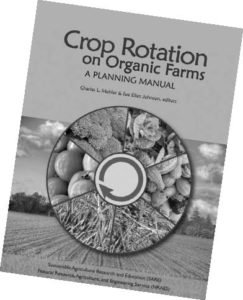Planning for Effective Crop Rotation on Diversified Farms
Good crop rotation practices are desirable for any farm. Some of the advantages that can be obtained from a well planned crop rotation include suppression of soil borne diseases, better weed control, suppression of some insect pests, improvement of soil quality, increased nutrient availability and reduced nutrient losses.

This new book provides an indepth review of crop rotation and its many applications, such as improving soil quality and health, and managing pests, diseases, and weeds.
Although many of the benefits of crop rotation are well understood scientifically and widely acknowledged by farmers, implementing a good crop rotation on a diversified vegetable farm is remarkably difficult. Many vegetable farms produce 30 or more crop species and the number of distinct varieties is usually even greater. Since acreage varies greatly from crop to crop, simply following crop A with crop B is rarely possible. Moreover many crops are planted at multiple dates during a typical growing season to achieve a more continuous harvest. These various plantings often require different preceding or following crops or cover crops. Finally, many farms consist of a mosaic of soil types and field conditions which restrict which crops can be profitably grown in a particular field.
To assist growers in planning crop rotations, the Northeast Organic Network (NEON) developed a book Crop Rotation on Organic Farms: a Planning Manual, edited by Charles L. Mohler and Sue Ellen Johnson which is available from the publisher NRAES. To ensure practical recommendations, the book is solidly based on farmer practice. NEON consulted two groups of farmers about their rotation practices. First, we assembled a panel of 12 exemplary growers nominated by farming organizations throughout the Northeast. farmers participated in a three day process designed to help them communicate exactly how they go about planning crop rotations. The second group consisted of 11 other farms. We did intensive case studies of their entire farming system, one aspect of which was crop rotation.
All of these growers rejected the textbook approach of Crop A follows Crop B follows Crop C. First, such an approach could not accommodate either the diversity of their crops or the complexity of their field conditions. Second, it was impractical due to unforeseeable effects of weather and changes in markets and labor availability. Instead, all growers focused on the ad hoc placement of particular crops in particular locations based on cropping history and field conditions. These exemplary growers knew the geography of their fields intimately. In addition, most kept careful records of what crops had been grown in each location during the past several years. They then chose the most suitable location for each crop. Although some crop locations might be suboptimal, overall, the farm would prosper. In addition to yields in the current year, they included aesthetic considerations, issues relating to ease of harvest, and constraints their choices placed on future cropping plans.
A relatively small subset of these growers did their ad hoc sequencing of crops within the context of a larger general rotation scheme. Some rotated vegetables with hay or with years with fallow and cover crops. A few rotated between broad categories of crops, with the particular crops within each category chosen on an ad hoc basis.
We took the strategies provided by these growers and developed a systematic procedure for assisting other growers (i) to develop generalized rotation plans and (ii) to allocate crops to field locations whether they use a generalized rotation plan or not. In addition, Crop Rotation Planning on Organic Farms contains information to help growers in making the necessary choices involved in rotation planning. This includes sections on use of rotation in the management of diseases, insects, weeds, soil health and mineral nutrition; extensive examples of crop rotations from real farms; the relation of intercropping to crop rotation; and crop rotation during transition to organic production.
Roughly one third of the book contains reference tables that list characteristics of crops relevant to rotation such as family and mineral use; persistence and dispersal mode for various diseases; crop sequences that help solve or create various disease, insect, weed, and soil problems; and weed characteristics, including crop diseases hosted by various weeds. The importance of tracking crop locations on the farm from year to year is emphasized. Tools are provided to make the creation of detailed field maps easy.
Crop Rotation on Organic Farms can be used in a variety of ways. It provides extensive reference material on a wide variety of topics related to crop rotation. It includes topical essays written in accessible language that explain how to address particular issues in crop rotation and farm design. By reading about how other growers solve problems, it provides inspiration on better ways to farm. Finally, it provides a step-by-step planning procedure that will allow even a beginning farmer to sequence crops as effectively as a highly experience grower.

